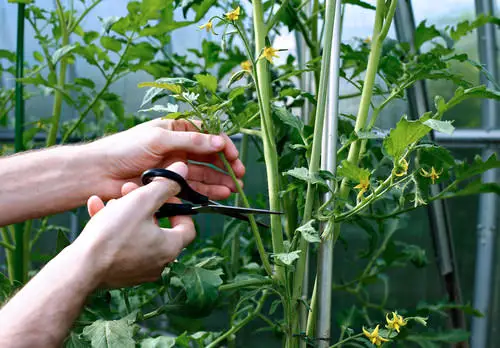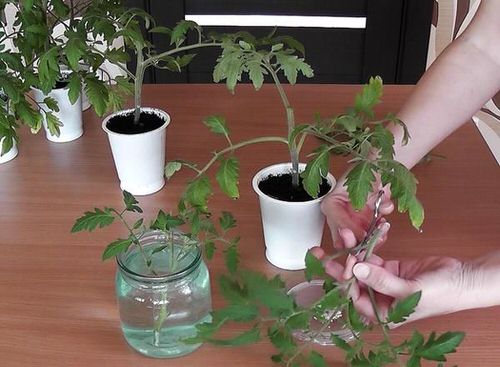Learn How to Grow Unlimited Tomato from Cuttings and clone several varieties of your favorite veggie in containers or garden for free!

Have you tried cloning vegetables at home? You can start with Solanum lycopersicum, which grows in almost every condition. Learn How to Grow Unlimited Tomato from Cuttings and cultivate a season-long harvest in simple steps!
Avoid these mistakes while growing Tomatoes for the best harvest
Why Grow Tomatoes from Cuttings?

Tomatoes are fast growers and can easily be grown from seeds, but propagating the plant from cuttings will help you clone a similar variety without waiting for weeks to get a proper fruiting plant.
Gardeners often end up thinning the seedlings whose roots are intertwined with each other. In such a case, growing the plant from cuttings becomes a valid and helpful option.
Check out the best tomatoes for hanging baskets here
Propagating Tomatoes from Cuttings is Easy
As compared to growing tomatoes from seeds, propagating from cuttings is a fuss-free process, where you save a lot of time.
The biggest advantage is, you can take cuttings from the plant that grows the juiciest and tastiest tomatoes and the upcoming plant would have similar features, meaning you will have the same plant growing the sweeter and tastier tomatoes!
Learn some brilliant hacks to grow tomatoes from seeds here
How to Grow Unlimited Tomato from Cuttings?

Growing tomato from cuttings is a pretty straightforward process and can give you unlimited harvest throughout the year!
- Get 4-6 inches cutting from a healthy plant, preferably with new leaves. Use clean and sterilized scissors for the process.
- Snip away the lower leaves and the flower buds if any—this will direct all the energy to grow new roots.
- Fill a pot with a soil mix and tuck the cutting gently into the soil.
- Keep the medium slightly moist all the time.
- Place the pot at a location with bright indirect light.
- In a week or two, the cutting will develop new roots.
- You can then transplant the cutting to a larger pot or in a raised bed of your vegetable garden with all the necessary conditions to help it thrive.
You can grow unlimited tomatoes this way from just one plant, as the plant tends to develop new stems every time you cut one.
These are the best Tomato varieties to grow
How to Increase the Sucess Rate While Growing Tomato from Cuttings
To ensure you have the maximum chances of success, keep the following points in mind:
- Dip the end of a cutting in a rooting hormone before planting. It will increase the propagation rate–here are the best DIY rooting hormone recipes.
- Take cuttings from a healthy plant that is producing lush foliage and plump, juicy fruits.
- Go for suckers, the point where a branch meets the main stem (the axil) for propagation. This way, you will be able to remove suckers while propagating them as new plants.
Splitting tomatoes? Check out the solutions here
Requirements of Growing Tomato Plants

1. Temperature
The ideal temperature range for a propagating tomato plant is 55-85 F, or 13-30 C. Tomatoes are not frost tolerant, hence cannot take temperatures below 35 F or 1 C.
2. Soil
Organic matter is important for growing healthy tomatoes since it improves drainage and supply nutrients steadily. Make sure you add plenty of compost and aged cow or chicken manure at the time of planting that is a must for excellent growth.
Also, these plants grow best in slightly acidic to neutral soil with a pH of 6-7.
3. Sunlight
Tomatoes thrive and produce plentiful fruits in 6-8 hours of sun per day. Avoid growing them in a shaded location or where they get only 1-2 hours of direct light.
Also, rotate the plant regularly if you are growing them in pots, as it will help every part to get sun exposure. Avoid placing immature tomato seedlings outside in the full sun.
4. Fertilizer
Before you pick a feed, it will be a good idea to do a little testing of the soil.
If the soil is balanced or high in nitrogen, go for a 5-10-5 or 5-10-10 feed. If the soil is low in nitrogen, then use a balanced fertilizer like 8-8-8 or 10-10-10. Use it once in 3-4 weeks, after diluting to half of its strength.
You can also go for specialized fertilizers that are meant for tomatoes, like Espoma.
Bone meal, soy meal, blood meal, and well-rotted manure work wonders for the plant too.
5. Water
Tomatoes don’t grow well in a dry growing medium—water the plant when the soil surface feels dry to touch. Also, while watering, make sure that it’s not spilling on the leaves as it can cause blight and other fungal diseases.
6. Pests and Diseases
Tomatoes are prone to several pests and diseases such as mealybugs, mites, aphids, blossom end rot, and beetles.
Spray the plant with an insecticidal soap solution or neem to keep the invaders at bay by following an organic approach.


